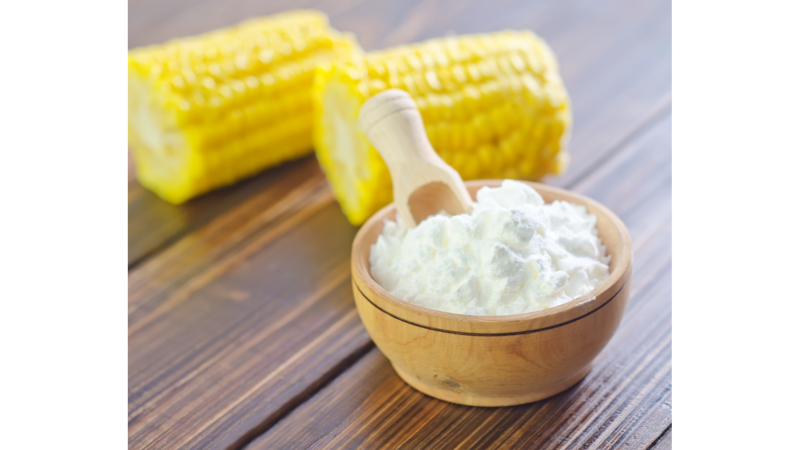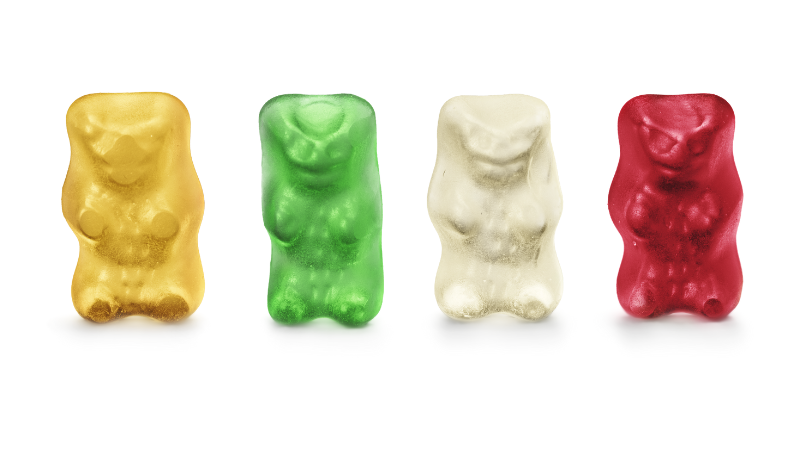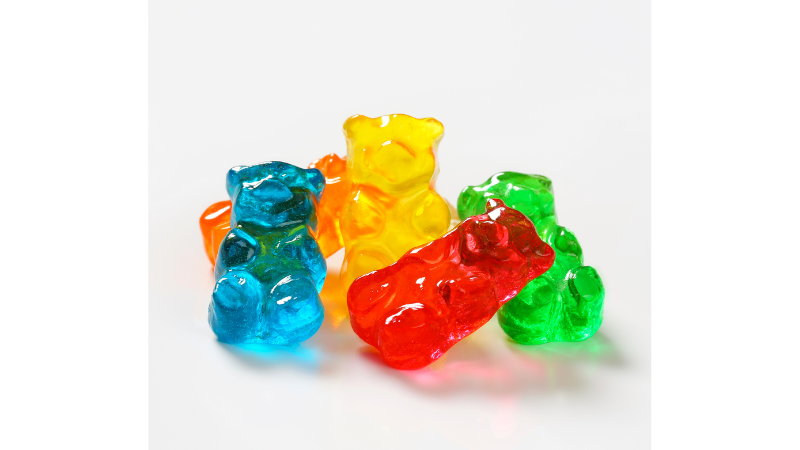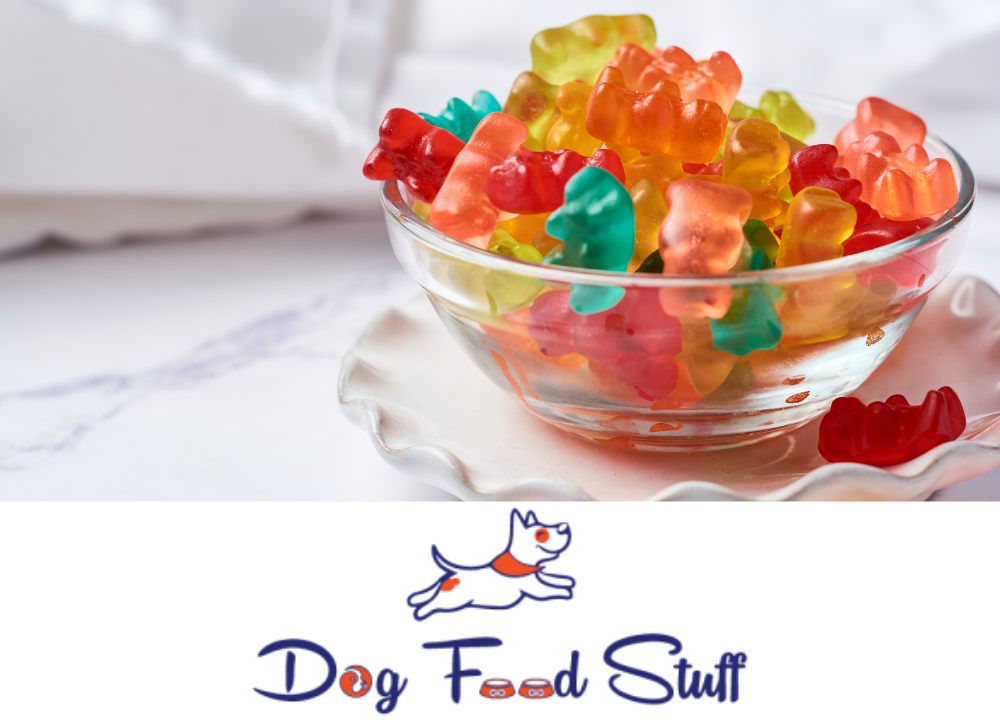Can Dogs Eat Gummy Bears? The Risks!
Risks of giving gummy bears to dogs!
Can dogs eat gummy bears? We’ve heard so much about popping in human foods to our dogs, but is gummy bear a safe treat to be passed on?
While human treats may not harm humans that much, the same when given to dogs can be harmful exponentially. Something like a gummy bear is a delicious treat for humans, but it is all the more harmful for your dogs.
All the sugar causes the harm to your dogs. So if you ask me can dogs eat gummy bears or not, my answer would be a big NO!
So, what are gummy bears?
Gummy bears are multicolored fruit candy. Another name for gummy bears are called jelly baby in other countries.
Gummy bears are mostly made in their bear shape and are about 20cm in size. However, this is not the only shape in which they are made. Gummy bears are made into various shapes and sizes.
Gummy bears were first created on Germany by the Haribo co. Now, they are consumed in almost every country of the world.
Ingredients involved in the production of Gummy Bears
There are so many ingredients that come together for the successful production of this gelatinous sweet. Most of these ingredients are artificially made while some are sourced from naturally existing food products
Gummy bears are an example of candies with vegan friendly variants. This means that the ingredients that are involved in the production of these sweets are 100% plant derived. No animal products were involved in the production process of such gummy bear variations.
Here are a few of the ingredients needed in the production of the sweets.
1. Sugar
All candy manufacturing involves the use of sugar. The main sugars involve in the production of gummy bears are glucose syrups and sucrose.
Glucose syrup is gotten mainly from corn but can also be obtained from foods like potatoes, wheat, barley etc.
Glucose syrup is used in food production as sweetener and moisture retainer. One of the qualities that makes it desirable by food manufacturers is the fact that glucose syrup does not crystallize.
Sucrose is also referred to as table sugar. It is extracted with water from sugarcane and sugar beet.
In candy production, sucrose is used as sweetener, preservative and texture modifier.
2. Gelatin
Gelatin is derived from collagen which is present in the body of animals. This is an ingredient that is not present in the vegan variant of this candy.
Gelatin is a colorless and flavorless food manufacturing ingredient. It serves a gelling agent in food, thickener, stabilizer and texture modifier.
3. Starch
Starch is a white powdery substance that is used in place of gelatin in vegan friendly variants of gummy bears.
Starch could serve as stabilizers, emulsifiers and other functions. However, in food production they are mostly used for their thickening ability.

4. Pectin
Pectin is another substance that is used in place of gelatin in the manufacturing of gummy bears. Pectin is found in the middle lamella and cell walls of plants.
The main component of pectin is a sugar acid derived from galactose. This acid is known as galacturonic acid.
The main purpose of pectin in food manufacturing is thickening.
5. Citric Acid
Citric acid is a weak organic acid that is found naturally in citrus fruits. Citrus fruits are lime, lemons, oranges and grapefruit.
The importance of citric acid in the production of gummy bears is as preservative. This is because bacteria cannot grow in acidic environments.
Another function that citric acid serves is as flavor enhancers.
6. Flavorings
When it comes to the flavorings used in the production of gummy bears, there is little information provided on that subject.
However, the major gummy bears flavors that exist in the US are strawberry, lemon, orange, pineapple and raspberry.
Hence, the flavoring that will be in use in the production of gummy bears will be in line of these major flavors listed above. The specific flavorings used remains unknown to the general public.
7. Artificial colors
Like flavors, there is also limited information given about what the colors used in the production of gummies are or are made up of.
All we can say are there are basic colors for every flavor of gummy bear. Red (raspberry), green (strawberry), yellow (lemon), orange (orange) and colorless or white (pineapple).

As with flavorings, the specific colorings remain a mystery to the general public but we sure know that those used would be in line with the colors of the various gummy pieces.
So, why are gummy bears harmful for dogs?
Since, there are many makers and variations of gummy bears, it is impossible to give a general answer to this question.
When it comes to regular gummies, the only cause for alarm would be the sugar content. However, for other variations like the sugar fee candies, there might be additions of some chemicals that can be dangerous to dog’s health.
Still, to be on the safer side, it is advisable to keep dogs as far away as possible from these sugary treats. Can dogs eat gummy bears? Here are some possible ingredients that gummy drops could contain, that could be injurious to dog’s health:
1. Sugar
While sugar is bit necessarily a bad thing to dog’s health, too much sugar can be quite threatening to the dog’s overall health. Here are some dangers of giving dogs overly sugary foods like gummy bears.
a. Upset Stomach
Like humans, the guts of dogs contain bacteria that helps them digest their food. However, an introduction of surgary food in the dog’s diet can mess the microbial balance.
This disruption could lead to the dog having an upset stomach. This could in turn lead to diarrhea and sometimes vomiting.
b. Cavities
It might be interesting to note that dogs also suffer from cavities.
This is due to the production of acids from sugars by the bacteria that reside in the animal’s mouth. These acids reduce the minerals in the enamel resulting in teeth diseases.
c. Obesity
This is sadly, a common problem with many pets. This is majorly caused by the over consumption of refined sugars which are just calories.
Not only do these dogs gain weight, obesity also exposes them to many risks like heart disease, joint problems and sometimes, difficulty breathing.
d. Hormonal Changes
Dogs need insulin to store sugar and consumption of excess sugar leads to over secretion of insulin. Insulin has the ability to affect other hormones and this can lead to hormone relayed diseases and infections.
The summary is that sugar can really affect the pet’s body and metabolism on general.
e. Diabetes
Diabetes is not only peculiar to humans, it is a disease that can affect dogs too. Diabetes occurs when the dog’s body produces little or no insulin at all. It could also be when the body has an abnormal response to insulin.
Symptoms if diabetes in dogs include excessive drinking of water due to extreme thirst, excessive urination, loss of appetite, cloudy eyes etc.
Overconsumption of sugary products is a main exposure to this sort of disease.
2. Xylitol
Xylitol is a sugar alcohol that is soluble in water. It is commonly used in the production of sweets, chocolate and chewing gum.
While this substance poses no threat to the wellbeing of humans, it can be extremely toxic to dogs and should be kept very far away from them
When xylitol are eaten, the body of dogs releases insulin (this does not occur in humans which is why we are not affected adversely by the consumption of these products).
The release of this hormone leads to hypoglycemia, a situation when the level of sugar in the blood drops drastically. This could be life threatening if not attended to promptly.
The consumption of xylitol could also lead to liver failure in dogs. These are the main reasons where feeding dogs chocolate is extremely frowned at. It is also a reason to keep the gummies away from your dogs to avoid poisoning.
So, can dogs eat gummy bears? It would be safe to conclude from the above, that No, it is not and should be avoided to be given to dogs.

Other human treats that are unsafe for dogs
Now that Apart from gummy bears, there are a lot of human treats that are unsafe for consumption by dogs. These substances when consumed by these furry animals could lead to several complications and if proper care is not taken, death.
1. Chocolate
Ranking first in this delight. This is no surprise for dog owners but many of them do not know why it is advised to keep their pets away from this treat.
The main ingredient in chocolates that is toxic to dogs is Theobromine.
Theobromine also known as xantheose is the primary butter tasting alkaloid that is found in cocoa and chocolate. In humans, this compound poses threats only when consumed in large doses. And even then, the dangers are not as immense.
This is however not the case with dogs. Theobromine affects so many systems in the dog’s body. These systems include the cardiovascular system, the respiratory system and the central nervous system.
It takes about two hours after consumption of theobromine before the signs and symptoms of poisoning begin to kick in.
Symptoms of theobromine poisoning include vomiting, excessive panting, hyper irritability and hyper excitation.
2. Chewing Gum
Another human enjoyed candy that cannot be consumed by dogs is chewing gum. The main ingredient responsible for this restriction is xylitol.
As mentioned above, xylitol results in an increased release of insulin which in turn leads to hypoglycemia in dogs.
3. Ice cream
Probably one of the most enjoyed treats, ice cream comes in different flavors and modifications. However, they should as much as possible be kept away from dogs.
This is because ice cream contains a large amount of sugar that can be quite injurious to dog’s health. This is because large sugar intake can lead to obesity diabetes and other forms of complications.
Sugar free ice creams are out of bounds to dogs also. This is because they often contain xylitol. Xylitol’s toxicity to dogs cannot be overemphasized. Hence, substances that are suspected to contain this chemical should be kept out of the reach of dogs.
Human Treats that Dogs Can Enjoy
There are many human sweets that should be kept away from dogs. At the same time, there are still some snacks that are safe for consumption.
1. Popcorn
Plain unsweetened popcorn are very good for dogs.
Popcorns contain some trace elements like magnesium, zinc and phosphorus which are essential for dog’s overall wellbeing
It is important however to make sure that no form of additives like sugar and salt are added during the making of this treat. Also, u popped corn should not be given to avoid choking.
2. Fruits
Although, these are bot considered ordinarily as treats, they are still consumed by humans as snacks.
Fruits are some of the cheapest and healthiest forms of snacks that can be offered to dogs. They contain so many vitamins and minerals that are essential for the wellbeing of dogs.
However, despite the benefits of fruits to dogs, it is important that they are administered cautiously. This is because some of them could cause stomach issues if they are given in large quantities.
Fruits like papaya, apples, pears, strawberries, watermelon can be given to dogs and are extremely safe for their consumption.
3. Vegetables
Another healthy form of snacks that can be enjoyed by bother dogs and humans are vegetables.
Vegetables, like fruits are packed with nutrients like vitamins and minerals and are readily available at very affordable prices.
However, there are a certain family of plants that are considered toxic for dog consumption. They are called Allium and they include onions, chives etc. These plants should not be given to dogs for consumption.
Apart from these, almost every vegetable is safe for consumption. However, some need to be cooked to make them tender, still not too much so that they do not lose their nutrients.
Summing-Up
Can dogs eat gummy bears? I’d say No and even if you want to give it as a taste enhancer, you should not dog. It builds greed and then you’d not be able to control it.
So, while giving it in a very small quantity will not harm your dog immediately, in the larger even of things it would.
This is because gummy bears have large sugar content. Also, sugar free gummy bears contain xylitol which is highly toxic and should be avoided by dog owners.
The bottom line remains that while gummy bears are not entirely dangerous for dogs, there are some flavors that could be threatening. Hence, for optimum safety of pets, they should be avoided as much as possible.
There are numerous safe and healthy snack choices, ranging from fruits to vegetables. You can even opt for dog treats that are specifically created for dogs. These contain nutrients that are beneficial and would do no harm generally to the wellbeing of the animals.

